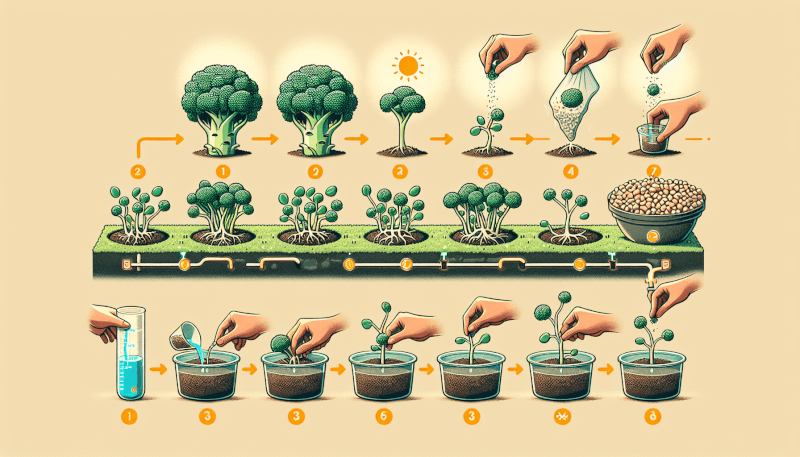👋 Click the mic button to talk to Alfred, the Todd's Seeds Gardening/Sprouting Expert – Feel free to ask him anything!
Ask Virtual Todd Anything - Click the Mic
If you’re a fan of broccoli and all its nutrient-packed goodness, then learning how to grow broccoli sprouts from seeds is a skill worth mastering. These tiny powerhouses of nutrition are easy to cultivate right in the comfort of your own home. From selecting the right seeds to providing the optimal growing conditions, this article will guide you through the simple steps to grow your own broccoli sprouts and enjoy their delicious and health-enhancing benefits. So grab your gardening gloves and get ready to embark on a journey of sprout-filled goodness!
Choose the Right Seeds
When it comes to growing broccoli sprouts, it is important to choose the right seeds. Look for organic and non-GMO seeds to ensure that you are starting with the best quality seeds for sprouting. Organic seeds are free from harmful chemicals and pesticides, while non-GMO seeds have not been genetically modified. By selecting these types of seeds, you can be confident that you are growing sprouts that are healthy and safe to consume.
In addition to choosing organic and non-GMO seeds, it is also important to choose a broccoli variety that is suitable for sprouting. Not all broccoli varieties are ideal for sprouting, so it is worth doing some research to find the best variety for your needs. Look for varieties that are known for producing abundant and flavorful sprouts. This way, you can ensure that you are getting the most out of your sprouting efforts.
To ensure that you are getting high-quality seeds, it is advisable to purchase them from reputable seed suppliers. Check out local nurseries, organic gardening stores, or trusted online seed suppliers. These sources are more likely to have seeds that have been stored in optimal conditions, increasing the chances of successful germination and sprouting.
Prepare the Sprouting Container
Before you begin the sprouting process, it is important to prepare a suitable container for your broccoli seeds. Aim for a shallow container with drainage holes to allow excess water to escape. This will prevent waterlogging and ensure proper airflow for the sprouts. You can use trays, plant pots, or even repurpose containers such as shallow food storage containers.
To ensure a clean and sterile environment for your sprouts, it is essential to clean and sterilize the sprouting container. Wash the container thoroughly with mild soap and warm water, and then rinse it well. Afterward, sterilize the container by soaking it in a solution of 1 part vinegar to 9 parts water for a few minutes. Rinse the container again with clean water to remove any residual vinegar.
Next, cover the bottom of the container with a layer of organic soil or potting mix. This will provide a growing medium for the seeds and ensure that they have the necessary nutrients to flourish. Make sure to use organic soil or potting mix to maintain the organic nature of your sprouts.

Soak the Broccoli Seeds
Once the container is prepared, it’s time to soak the broccoli seeds. Begin by measuring the desired amount of seeds for sprouting. It’s generally recommended to start with about 1-2 tablespoons of seeds, depending on the size of your container and how many sprouts you want to grow.
Place the measured seeds in a clean bowl or jar and cover them with filtered water. It is crucial to use filtered water to prevent any chemicals or contaminants from interfering with the sprouting process. Allow the seeds to soak overnight or for approximately 8-12 hours. This soaking period will help soften the seeds and initiate the germination process.
Rinse and Drain
After the soaking period, it’s time to rinse and drain the soaked seeds. Pour the soaked seeds into a fine-mesh sieve or strainer to separate them from the water. Rinse the seeds thoroughly with clean water to remove any residue or impurities. Gently swish the seeds around in the sieve to ensure that all surfaces are rinsed.
After rinsing, allow the excess water to drain from the seeds completely. Shake the sieve gently to remove any remaining water and debris. It is essential to remove excess water to prevent mold or fungal growth on the sprouts.

Spread the Seeds in the Container
Once the seeds are rinsed and drained, it’s time to spread them in the prepared sprouting container. Evenly distribute the rinsed seeds on top of the layer of organic soil or potting mix. Spread them out to ensure that each seed has ample space for growth and proper airflow. Avoid overcrowding the container, as this can lead to mold or stunted sprout development.
Gently press the seeds into the soil to ensure good contact and encourage germination. You can use your fingers or the back of a spoon to lightly press the seeds into the soil. This will also help the seeds absorb moisture from the soil, aiding in the sprouting process.
Maintain appropriate spacing between the seeds to prevent them from competing for resources. The exact spacing will depend on the size of your container and the amount of seeds planted. Generally, aim for about half an inch (1.27 cm) between each seed to allow sufficient room for growth.
Provide Optimal Growing Conditions
To ensure successful sprouting, it is essential to provide optimal growing conditions for your broccoli seeds. Place the sprouting container in a warm and well-lit area. Broccoli sprouts thrive in temperatures between 60-70°F (15-21°C). Avoid exposing the container to direct sunlight, as this can cause overheating and damage the sprouts. However, make sure the area receives enough indirect sunlight to support healthy growth.
You can place the container near a window or use grow lights to provide adequate light for the sprouts. If using artificial lights, ensure they emit the appropriate spectrum of light for optimal sprout development. Maintain a consistent temperature throughout the sprouting process to encourage steady growth and minimize stress on the sprouts.
Water the Sprouts Regularly
Proper watering is crucial to the success of your broccoli sprouts. Use a spray bottle filled with clean water to mist the sprouts gently twice a day. This will help keep the sprouts hydrated without overwatering them. Aim to keep the soil moist but not waterlogged, as excess moisture can create an environment conducive to mold or fungal growth.
Observe the moisture level of the soil regularly and adjust the watering frequency accordingly. If the soil feels dry, gently mist the sprouts to provide moisture. On the other hand, if the soil feels excessively wet, allow it to dry out slightly before watering again.
Harvest the Broccoli Sprouts
After about 5-7 days of growth, your broccoli sprouts will be ready for harvest. Look for young leaves developing on the sprouts as an indication of readiness. Once the sprouts have reached the desired size and developed their young leaves, it is time to harvest them.
To harvest the sprouts, cut them just above the soil level using clean scissors or shears. Make sure to sanitize your cutting tool beforehand to minimize the risk of contamination. Harvest only what you need, leaving the remainder to continue growing for future harvests.
Store and Consume the Sprouts
After harvesting, it is important to rinse the sprouts thoroughly with cold water to remove any dirt or debris. Gently pat them dry using a clean towel, ensuring they are free from excess moisture. To store the sprouts, place them in airtight containers and store them in the refrigerator.
Broccoli sprouts can be stored in the refrigerator for up to a week. However, it is recommended to consume them as soon as possible to enjoy their freshness and nutritional benefits. Incorporate them into salads, sandwiches, or smoothies for a healthy and flavorful addition to your meals.
Repeat the Process
To continue enjoying the benefits of fresh and homegrown sprouts throughout the year, save a portion of the harvested sprouts for seed production. Allow these saved sprouts to grow further until they produce mature flowers and subsequently seeds. Harvest the seeds, ensure they are fully dry, and store them in a cool, dry place for future sprouting endeavors.
When you are ready to grow new batches of broccoli sprouts, simply follow the same process outlined above. Use the stored seeds as your starting point, soak them, rinse them, and plant them in a prepared sprouting container. With each cycle, you will gain more experience and improve your sprouting skills, allowing you to consistently produce fresh and nutritious broccoli sprouts at home. Enjoy the satisfaction of growing your own food and reap the rewards of a healthy and sustainable lifestyle.
In conclusion, growing broccoli sprouts from seeds is a rewarding and fulfilling gardening endeavor. By choosing the right seeds, preparing the sprouting container, soaking the seeds, rinsing and draining them, spreading them in the container, providing optimal growing conditions, watering regularly, harvesting the sprouts, and properly storing and consuming them, you can successfully grow your own broccoli sprouts. By repeating the process and saving seeds, you can enjoy the benefits of fresh and homegrown sprouts throughout the year. So why not give it a try? Start your journey to growing delicious and nutritious broccoli sprouts today!